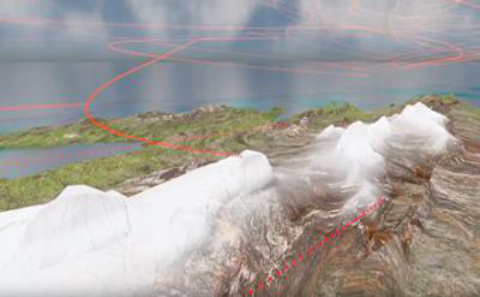
The occurrence of natural disasters, such as earthquakes, often have long-lasting repercussions in terms of damages to existing communication infrastructure, thus hampering coordination in search and rescue efforts. Consequently, it is crucial for emergency workers to have a rapidly deployable communication network in place to support rescue operations. In such scenarios, a swarm of powered fixed-wing drones may be employed to form a communication mesh, to hop messages across a large area [1]. Some of the drones in the swarm may also be allocated as runners, to physically fly information from one zone to another. However, the operability of such communication network is severely constrained by the limited endurance on individual drones.
The proposed PhD project considers an alternative solution through the exploitation of thermal columns by aerial gliders [2,3]. Thermals are columns of upward moving air-currents in low altitudes of the earth's atmosphere, caused by the uneven heating of the earth's surface (see [4] for model of thermals). They typically occur above dark regions of the earth's surface -- absorbing more heat. Gliders may exploit the thermals as a source of lift, gliding from one thermal column to another to remain airborne. For a human pilot, localising a thermal is a complex process involving many subtle cues, thus being difficult to replicate in an autonomous glider. However, a swarm of gliders, spread out across a large expanse, may be able to guide each other into thermals they have flown into [5]. The project aims to create such a constellation of gliders to cover a large expanse of land with a communications relay.
The following challenges will be addressed in this project:
- Develop simulation framework of a UAV swarm and dynamically evolving thermals.
- Develop computationally and communication efficient swarm coordination algorithms for a large scale (50-100) swarm of low-cost gliders to maximise their time in the air, while maintaining a dynamically changing, distributed map, of the location of discovered thermals.
- Evolving coordinated responses of the swarm to changing environments.
- The swarm communicating to a human operator the 'health' of the communication relay, and whether additional gliders need to be launched from the base station.
Key Skills
Strong programming skills, good math and statistical analysis.
Register for PhD Computer Science
Supervisors:
Danesh Tarapore (Electronics and Computer Science) - dst1m17@soton.ac.uk
Andras Sobester (Aeronautics, Astronautics and Computational Engineering) - a.sobester@soton.ac.uk
[1] Hauert, S., Zufferey, J. C., & Floreano, D. (2009). Evolved swarming without positioning information: an application in aerial communication relay. Autonomous Robots, 26(1), 21-32.
[2] Allen, M. (2005, January). Autonomous soaring for improved endurance of a small uninhabitated air vehicle. In 43rd AIAA Aerospace Sciences Meeting and Exhibit (p. 1025).
[3] M. J. Allen and V. Lin, (2007) “Guidance and control of an autonomous soaring UAV,” National Aeronautics and Space Administration, NASA Dryden Flight Research Center, Edwards, California, Tech. Rep., 4.
[4] Allen, M. (2006, January). Updraft model for development of autonomous soaring uninhabited air vehicles. In 44th AIAA Aerospace Sciences Meeting and Exhibit (p. 1510).
[5] Antal, C., Granichin, O., & Levi, S. (2010, December). Adaptive autonomous soaring of multiple UAVs using simultaneous perturbation stochastic approximation. In 49th IEEE Conference on Decision and Control (CDC) (pp. 3656-3661). IEEE."